Exploring the Natural Citrine Stone: An In-Depth Analysis
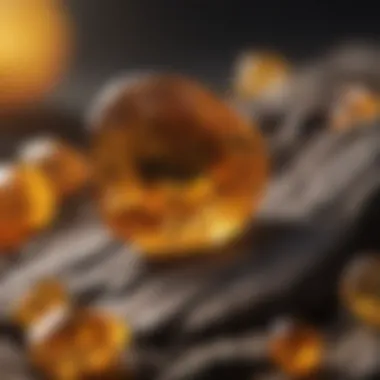

Intro
When diving headfirst into the world of gemstones, the natural citrine stone stands out, shimmering with its warm, golden hues. This gem is cherished not only for its eye-catching appearance but also for its rich history and purported metaphysical properties. Whether you're a seasoned collector or just beginning your journey through the intricate landscape of rocks and minerals, understanding the citrine can offer both aesthetic enjoyment and spiritual insight. In this exploration, we will take a closer look at the geological formation of citrine, its significant place in history, current applications, and practical tips on how to identify and care for this striking mineral.
Featured Collectible of the Month
Overview
Citrine is a variety of quartz that exhibits a range of colors from pale yellow to deep orange and even brown hues. Unlike its more commonly recognized counterpart, amethyst, which people associate with purple shades, citrine captures the eye with its sunny personality. Known as the “merchant's stone,” it has long been believed to attract prosperity and success. Many collectors seek it not only for its radiant beauty but also for its perceived ability to manifest abundance.
Historical Significance
Citrine has a storied past that stretches back thousands of years. Ancient civilizations, including the Egyptians and Greeks, valued the stone, often using it in jewelry and amulets. The Romans, in particular, carved it into various shapes, turning citrine into a popular adornment. Interestingly, citrine has also been linked to the spiritual teachings of Buddhism, being regarded as a stone that brings clarity and insight. Although natural citrine is relatively rare, due to the abundance of heat-treated or artificially colored amethyst in the market, genuine pieces maintain their prized status among collectors.
"The striking color of citrine glows like a piece of sunlight captured in stone, embodying warmth and positivity while standing as a testament to the Earth's rich geological processes."
Identification Techniques
Identifying natural citrine from other similar-looking stones can be quite a puzzle for many. However, with a keen eye and some knowledge, it’s entirely manageable.
Visual Characteristics
To effectively spot a true piece of citrine, consider the following traits:
- Color: Genuine citrine ranges from pale yellow to brownish-orange. The clearer the stone, the more desirable it is.
- Clarity: Look for inclusions. Natural citrine is usually less flawless than synthetic or heated options.
- Hardness: As a variety of quartz, it has a Mohs hardness of 7, making it relatively sturdy.
- Double Refraction: Through a loupe or magnifying glass, you may notice that citrine shows signs of double refraction, unlike some imitation stones.
Resources for Identification
For those looking to dive deeper into the identification process, consider these resources:
In wrapping up this introduction, it's evident that the natural citrine stone is much more than just a pretty face. Its unique qualities, historical importance, and captivating stories make it a treasured collectible. From examining its characteristics to learning how to care for it, our exploration of citrine promises a rich journey through nature's artistry.
Preamble to Natural Citrine Stone
Natural citrine, a stunning gemstone known for its vibrant yellow to orange hues, holds a significant place not only in the jewelry industry but also among rock and fossil collectors. This captivating stone is often celebrated not only for its aesthetic appeal but also for its purported metaphysical properties, making it a fascinating subject for an in-depth exploration.
Citrine, a member of the quartz family, is frequently associated with qualities of positivity and warmth. Understanding these characteristics forms the foundation for appreciating the value of citrine beyond its surface beauty. For collectors, this stone offers a journey into its geological origins, a glimpse into its historical relevance, and insights into its practical applications today.
Take for example a collector who, while curating their collection, opts for natural citrine over its synthetic counterparts. The choice embodies a commitment to authenticity, which resonates deeply among enthusiasts who appreciate the story each stone carries.
Understanding Citrine
So, what exactly is citrine? At its core, citrine is a quartz variant whose color can range from pale yellow to deep amber. Its color comes primarily from iron impurities within the crystal structure. The process and conditions under which citrine forms contribute to its diverse range of shades and clarity, making each specimen unique. Unlike other quartz types, such as amethyst, citrine does not just share the same chemical composition but also embodies distinct characteristics that merit close examination.
"Citrine is more than just a pretty stone; it encapsulates geological and cultural history within every facet."
When looking to add citrine to a collection, it's important to consider not just its visual attributes but also its origin. The most sought-after natural citrine is mined from locations such as Brazil and Madagascar, where the right geological conditions create the perfect environment for its development. Each piece holds a story, whether it’s from the depths of an ancient mine or the vibrant markets of contemporary gemstone traders.
Thus, this section provides a crucial context for appreciating the natural citrine stone, setting the stage for a comprehensive exploration of its geological formation and properties in the subsequent sections.
Geological Formation of Citrine
Understanding the geological formation of citrine offers valuable insight into the stone’s characteristics and origins. This section is crucial for both collectors and enthusiasts, as it provides a foundation for recognizing authenticity, appreciating value, and understanding the processes that create this stunning gem. The natural beauty of citrine is intimately connected to its geological story, made by heat and time, shaping crystals through various environmental conditions.
The Formation Process
Citrine is primarily a member of the quartz family, but its distinct golden hue sets it apart. To comprehend how citrine comes into existence, one must delve into its formation process.
Citrine forms when silicon dioxide undergoes changes due to heat. Typically found in igneous rocks or in alluvial deposits, citrine develops when iron impurities within the quartz are subjected to high temperatures. This can occur naturally in the Earth due to volcanic activity or through hydrothermal processes, where mineral-rich water circulates through rock formations.
- The heating process may range from 300 to 500 degrees Celsius.
- The presence of iron creates either a yellow or brown color as it oxidizes.
- Over time, these crystals can form in roughly six-sided shapes, known as hexagonal prisms, commonly found in locations such as Brazil or Madagascar.
Understanding this process is not just about geology; it relates directly to the gem’s value. Heat-treated citrine, often a more common sight in jewelry stores, lacks the geological history of natural citrine. Thus, recognizing the true origin can affect its worth significantly.
Citrine vs. Other Quartz Varieties
When comparing citrine with other quartz varieties, it becomes clear that each type tells its own story. For instance, amethyst, another well-known quartz, is simply citrine under different conditions.

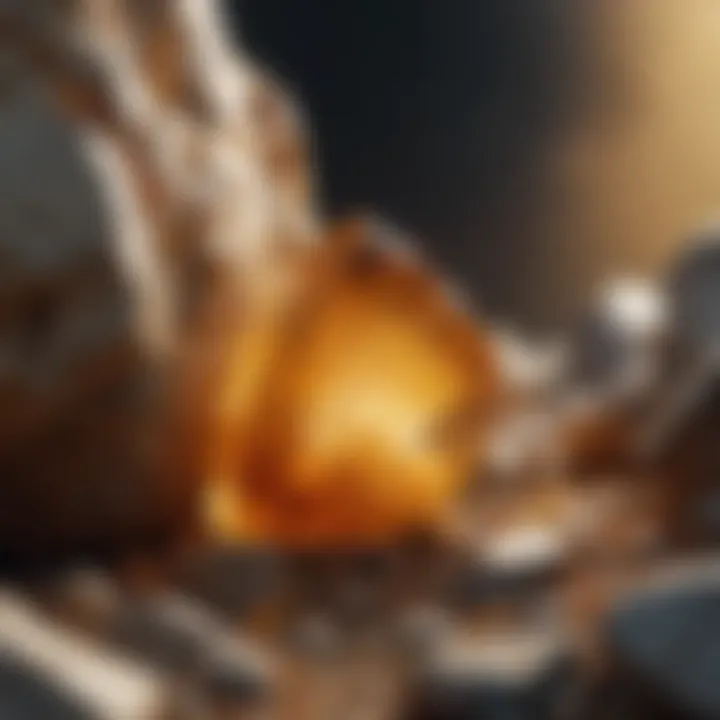
- Amethyst: Purple in color, forms in environments that have lower heat conditions than those needed for citrine.
- Smoky Quartz: Characterized by its grey or black shades, this variation comes from a different type of irradiation.
- Rose Quartz: Its alluring pink hue often symbolizes love and tranquility, differing significantly in composition from citrine.
These distinctions are not just academic; they have real-world implications for collectors. Knowing how to differentiate between these varieties not just aids in identification but also enriches the collector’s experience.
"Citrine's unique formation process and comparisons with other varieties enrich understanding and appreciation for this distinct stone."
By digging deeper into the geological formation of natural citrine, one gains an understanding crucial not just for appreciation but also for potential investment, signaling an awareness of the broader value rooted in its geological origins.
Properties of Natural Citrine
When we talk about the properties of natural citrine, we touch upon what makes this gemstone not just aesthetically appealing but also intriguing from a scientific and metaphysical standpoint. Understanding these properties helps enthusiasts, collectors, and even casual admirers grasp the value and significance of citrine, paving the way for informed discussions and decisions regarding their collections or purchases.
Physical Characteristics
Citrine has a striking appearance that immediately catches the eye. Its color often ranges from pale yellow to deep brownish orange. This spectrum is crucial because it can evoke different emotional responses and serve various purposes in jewelry and decoration. The physical properties of citrine include a hardness of 7 on the Mohs scale, making it relatively durable for everyday wear in jewelry.
- Transparency: Natural citrine offers a bright, radiant clarity. The quality of a citrine can be gleaned from how the light interacts with its surface. A good-quality stone will have almost no inclusions and a well-balanced color.
- Luster: With its strong vitreous luster, citrine can add a glossy finish to any piece of jewelry, enhancing its overall appeal.
Overall, the physical features of citrine not only contribute to its beauty but also make it a practical choice for wearers who seek both style and durability.
Chemical Composition
Diving a bit deeper into the science, we find that citrine is actually a variety of quartz. Its chemical formula is SiO2, or silicon dioxide. What differentiates citrine from other quartz types lies in its trace elements. The yellow hue primarily arises from the presence of iron impurities combined with natural irradiation and heat during its formation process.
- Composition Breakdown:
- Silicon: 46.74%
- Oxygen: 53.26%
- Trace Elements: Iron, among others, contributes to the unique color.
Knowing the chemical makeup can assist collectors in distinguishing citrine from imitations or treated versions, which may not possess the same characteristics.
Color Variations
The color variance in citrine is one of its most charming aspects. The hue can influence both its market value and its metaphysical properties as perceived in healing practices. Whether you prefer the lighter shades that resemble champagne or the deeper hues that echo the warm glow of autumn leaves, each color has its appeal.
- Light Yellow: Often seen as cheerful and vibrant, these stones are thought to promote optimism.
- Deep Orange: Richer stones are associated with vitality and are believed to offer protection and energy.
- Brownish Tones: These are rare but carry a grounding effect, often linked with stability.
"The beauty of citrine isn’t just skin deep; its hues carry meanings and can resonate with the wearer’s spirit."
Understanding these color differences helps in identifying gem quality and can significantly influence choices when it comes to purchase or collection.
In summary, the properties of natural citrine—spanning its physical characteristics, chemical composition, and color variations—collectively forge a unique identity for this gemstone. Such knowledge equips rock and fossil collectors with the expertise needed to appreciate citrine fully, whether in their collections or when engaging with other enthusiasts.
Historical Significance of Citrine
The historical significance of citrine cannot be understated. This striking stone has not only captured the human imagination with its vibrant hues but has also played an important role in cultures throughout history. Cultures from ancient times to the modern era have attributed various meanings and uses to citrine, making it a fascinating subject of study for gem enthusiasts and historians alike. Understanding this context enhances one's appreciation of citrine, as it reflects both its aesthetic appeal and the multifaceted roles it has played.
Citrine in Ancient Cultures
In the haze of ancient history, citrine was revered by many civilizations. The Egyptians, in particular, recognized the beauty and charm of this gem. It was often set in jewelry, seen as not just an adornment but a protective talisman believed to ward off negative energies. The color of citrine, reminiscent of the golden sun, symbolized warmth, vitality, and prosperity.
The Greeks, too, held citrine in high regard, often carving it into intaglio seals. These seals were not merely for decoration; they served practical purposes, such as signing documents and protecting belongings. Such artifacts have been found in archaeological sites, speaking to the stone's value across time.
"Citrine, with its sunny disposition, has long been associated with abundance and success, making it a favored stone among traders and merchants."
Moving to the East, we find that in Ayurvedic practices, where colors represent different energies, citrine is aligned with enlightenment and creativity. Having it nearby was said to enhance focus and clarity.
Citrine in Modern Gemology
In contemporary gemology, citrine continues to hold an esteemed position. Modern collectors and gemologists appreciate it not just for its visual appeal but also for its geological properties. Citrine has a distinct chemical makeup, primarily silicon dioxide, and its vibrant colors arise from trace amounts of iron. As a result, it has become an integral part of both academic studies and enthusiast collections.
In the modern marketplace, natural citrine is differentiated from heat-treated varieties, a distinction that affects both value and classification. The gem's qualities are examined through rigorous testing, ensuring that collectors receive authentic specimens. This focus on authenticity reflects a broader trend in gemology: the importance of knowing one's stone.
When engaging with citrine, buyers are advised to consider factors such as clarity, cut, and color saturation to evaluate its quality effectively. As the market fluctuates, staying informed about current trends is vital for those looking to add citrine to their collection.
Citrine endures through periods of change, maintaining its relevance in both the crafting of exquisite jewelry and in the realm of collectors. The merging of ancient beliefs about its powers with today's scientific understanding makes citrine a unique gem, bridging time and culture.
Metaphysical Properties and Uses
Citrine is not just a feast for the eyes; it’s renowned for its range of metaphysical properties that have fascinated gem enthusiasts and spiritual seekers alike. Many believe that this vibrant stone is a powerhouse of positive energy and well-being. It’s often considered the stone of abundance, helping to manifest prosperity and success. The interest in the metaphysical aspects of citrine injects a fascinating angle into the overall exploration of this captivating gemstone.
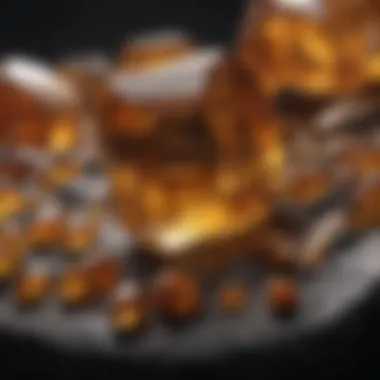
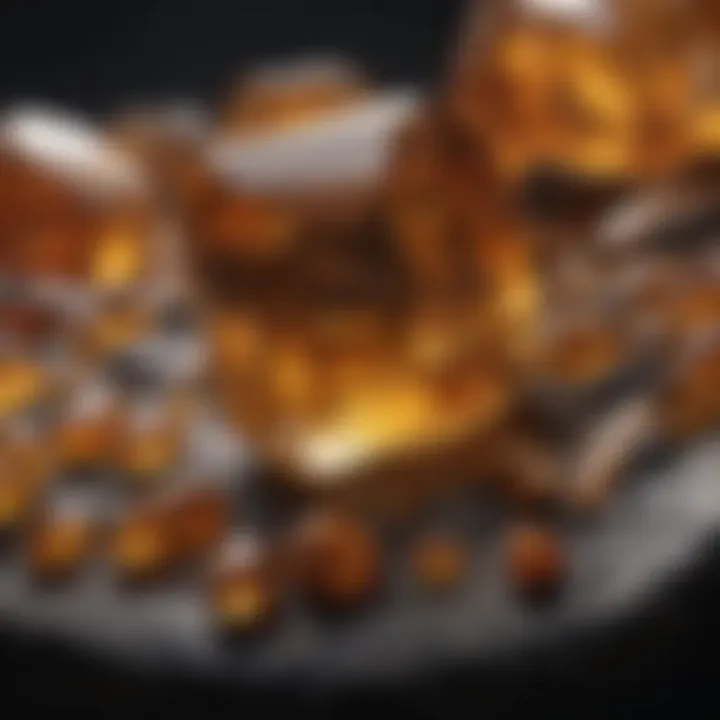
Citrine in Crystal Healing
In the realm of crystal healing, citrine is frequently referred to as a natural healer. Practitioners use this gem to promote clarity and enhance mental awareness. It’s said to stimulate the crown and solar plexus chakras, encouraging self-expression and creativity. Some hold that carrying or wearing citrine can work wonders when it comes to overcoming emotional challenges like fear and anxiety.
Citrine’s warm hues make it a gentle companion in spiritual work. Often, it is placed in spaces intended for meditation or relaxation. For those looking to create an uplifting atmosphere, placing raw citrine on a windowsill or within a part of your home dedicated to peace can invite positive vibrations.
Here are some more specific benefits associated with citrine in crystal healing:
- Stress Relief: It’s thought to reduce stress and foster a more optimistic outlook on life.
- Energy Booster: Many believe it brings vibrant energy to those feeling low or fatigued.
- Enhancement of Willpower: Users often report that citrine helps them achieve their goals by increasing their inner strength.
Citrine's Influence on Energy
The energy of citrine is often described as sunny and invigorating, almost like having a little piece of sunlight in your pocket. This stone is said to carry the energy of the sun—bright, cheerful, and empowering. Many people embrace citrine for its purported ability to energize the solar plexus chakra, which serves as the center for personal power and confidence. This makes citrine a favored choice for people who wish to strengthen their self-esteem and manifest their aspirations.
Benefits of Citrine's Energy:
- Increased Motivation: Those who use citrine often report an uplift in motivation, prompting them to take actionable steps toward their dreams.
- Clarity of Intention: Citrine is known to assist in sharpening focus and clarifying one’s intentions, making it easier to align actions with desired outcomes.
- Conversion of Negative Energy: It’s claimed that citrine can absorb and transform negative energy, turning it into vibrant energy that fuels creativity and positivity.
"Citrine is a stone that invites prosperity and warmth, enhancing your ability to make decisions by clearing away doubt."
Care and Maintenance of Citrine
The significance of taking care of citrine stones goes beyond mere aesthetics; it's an investment in their longevity and vibrancy. Natural citrine is a quartz variety and can be somewhat durable, but like any beautiful gem, it requires careful handling to preserve its allure. Maintaining these stones not only enhances their visual appeal but also keeps their metaphysical properties intact. Proper care can prevent scratches and dullness, ensuring that every facet sparkles with its characteristic lemon-yellow glow.
Cleaning Techniques
Keeping your citrine clean is essential to maintaining its brilliance. Over time, dust and oils from your skin can accumulate on the stone, diminishing its luster. Here are several techniques to consider when cleaning your citrine:
- Gentle Soap and Water: A simple solution of warm water with mild soap is typically enough to cleanse most citrine pieces. Use a soft cloth or a brush with soft bristles to gently scrub the surface. Avoid any abrasive materials that could scratch the stone.
- Avoiding Harsh Chemicals: Stay away from harsh cleaners or chemicals that could damage your stone. Citirine can be sensitive to acidic substances, which may dull its polish.
- Ultrasonic Cleaners: If you're dealing with intricate designs, an ultrasonic cleaner can be very effective. However, ensure that the settings are on a gentle cycle to avoid damaging the stone or any settings it may have.
To ensure effective cleaning, consider the following tips:
- Always rinse the stone thoroughly after washing to remove any soap residue.
- Pat dry with a soft, lint-free cloth rather than rubbing, which might create scratches.
- For jewelry, make sure to clean it regularly but avoid over-cleaning, as this could wear down any settings over time.
"Proper care not only enhances the stone's appearance but also maintains its intrinsic energy."
Storage Guidelines
Next, proper storage plays a crucial role in ensuring that your citrine remains in pristine condition. Here are some guidelines to follow:
- Store Separately: To prevent scratching and damage, store citrine separately from other gemstones. Using a fabric-lined box or pouch is a good start. This simple measure goes a long way in keeping your stones from chipping.
- Avoid Direct Sunlight: While citrine naturally enjoys sunlight, prolonged exposure can actually fade its vibrant colors over time. Store stones in a cool, dry place, away from direct sunlight.
- Humidity Control: Excess moisture can be detrimental, leading to mold or damages. A dehumidifier in your storage area can help maintain an optimal environment.
- Regular Check-ups: Examine your gemstones every now and then for signs of wear or wear. Early detection can prevent bigger issues down the line.
How to Identify Authentic Citrine
Identifying authentic citrine is paramount for collectors and enthusiasts alike. Not all that glimmers is genuine citrine. In the gem world, particularly with citrine, distinguishing between natural and heat-treated stones holds significant weight. As citrine becomes more popular, the market has seen an influx of treated versions that lack the same characteristics as naturally formed stones. Understanding the nuances can not only enhance the quality of one’s collection but also safeguard against financial pitfalls.
Distinguishing Natural from Heat-Treated Citrine
When hunting for authentic citrine, the first step is recognizing how to tell natural stones apart from their heat-treated counterparts. Heat treatment is a common process used to enhance the color of citrine, making it more vibrant. However, this enhanced appearance can be deceiving. Natural citrine generally possesses a more muted hue, ranging from pale yellow to deeper orange-brown shades, whereas heat-treated varieties tend to showcase an excessively bright or unnatural color.
One key indicator is the internal inclusions found in natural citrine. During its formation, natural citrine may carry unique inclusions that serve as fingerprints of its origin, often resembling feather-like patterns or tiny gas bubbles. In stark contrast, heat-treated citrine often appears more ‘clean’ or ‘clear’, lacking those distinct inclusions. Here are a few tips to distinguish between the two:
- Color Consistency: Observe the uniformity of color. Natural citrine will often display color gradients.
- Check for Inclusions: Use a jeweler’s loupe to check for unique patterns or inclusions.
- Look for Fractures: Natural stones can also have minor imperfections that indicate authenticity.
"Not every sparkle will lead you to treasure; take time to scrutinize the stone."
Using Tools for Identification
Equipping oneself with the proper tools can enhance the process of identification significantly. The right instruments can help both novices and experts alike confirm the authenticity of citrine with greater precision. Here are some methods and tools that can be utilized:
- Loupe or Microscope: This is essential for examining inclusions and surface characteristics. It will provide a closer look at the stone's internal structure.
- Refractometer: This tool helps measure the refractive index of the stone, a distinct feature between citrine and other quartz varieties.
- Polariscope: Detects birefringence, assisting in distinguishing different types of gemstones.
It is also essential to keep a keen eye out for documentation if you are purchasing from retailers or dealers. Authentic stones often come with certificates that detail their origin and treatments.
By mastering the identification of natural citrine, collectors not only enhance their collections but also nurture a deeper appreciation for the gem’s natural beauty and characteristics.
Citrine in Jewelry and Fashion
Citrine, with its warm golden hues, has captured the hearts of jewelers and fashion enthusiasts alike. Its unique color not only brings vibrancy to a piece of jewelry but also allows its wearer to express personal style in a way that few other stones can. In this section, we’ll explore the significance of citrine in the jewelry industry and the current trends influencing its usage and design.
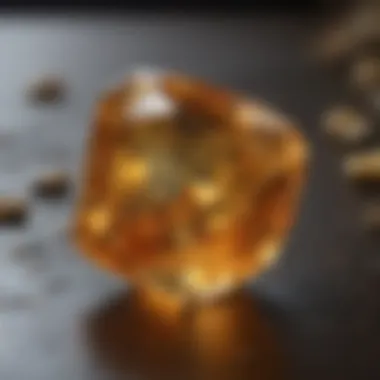
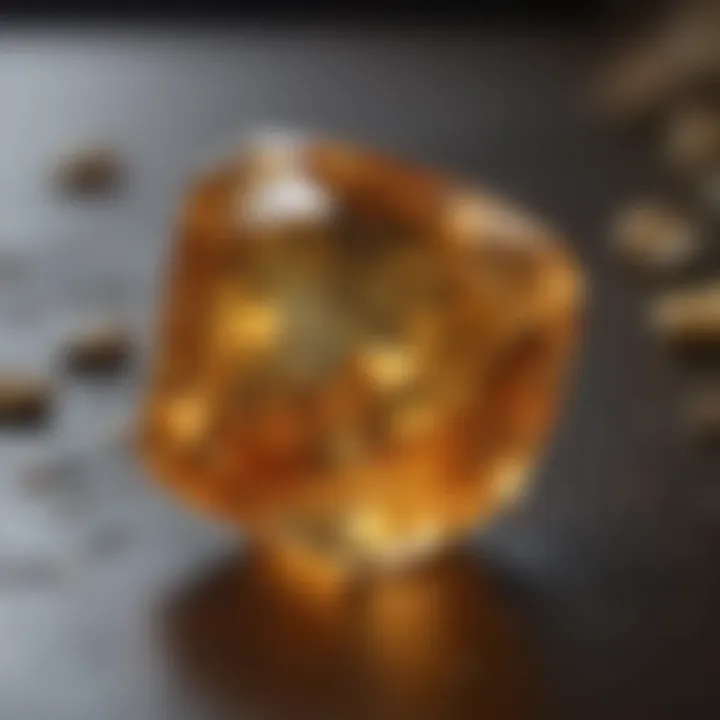
Designs Featuring Citrine
When it comes to designing jewelry featuring citrine, many artisans have leaned towards both traditional and innovative approaches. For instance, classic pieces often incorporate citrine in solitaires or clusters, allowing the stone's brilliance to take center stage. Citrine rings, particularly in vintage styles, are seen as timeless and elegant. Here, the natural golden color of the stone pairs beautifully with yellow or white gold, creating an aura of sophistication.
In contrast, contemporary designers are getting creative by combining citrine with other gemstones, such as aquamarine or amethyst. This trend not only enhances the visual appeal but also allows for unique storytelling through colors and shapes. Jewelry featuring citrine can also be found in playful designs, such as earrings or pendants crafted in abstract forms, providing a bold statement for any outfit.
Additionally, some artisans are opting for unconventional cuts. Think of asymmetrical shapes or geometric styles that bring a modern twist to this classic stone.
Consider these aspects when selecting citrine jewelry:
- Color Depth: Look for a vibrant and saturated hue, which can enhance the overall elegance of the piece.
- Cut Quality: The way citrine is cut affects its sparkle. A well-cut stone will reflect light beautifully.
- Setting: The choice of metal and design of the setting can greatly influence the stone's appearance and durability.
Market Trends in Citrine Jewelry
In recent years, the market for citrine jewelry has been witnessing interesting shifts. The demand for unique pieces has led to greater popularity of citrine among collectors and fashion enthusiasts. Unlike the common diamond or sapphire, citrine's distinctive charm sets it apart, garnering attention for its affordability and accessibility.
- Sustainability Matters: The increasing focus on ethical sourcing has influenced consumer choices. Many purchasers are now interested in where their gemstones are coming from. This emphasizes the importance of sustainable mining and responsible business practices.
- Rise of Customization: There’s a growing trend in personalization, where individuals are seeking bespoke citrine pieces that resonate with their personal stories. Jewelers are responding by offering customized designs, allowing buyers to select everything from the stone to the metal, ensuring each piece is unique.
- Online Influence: Online marketplaces and social media platforms have made it easier for artisans to reach a wider audience. Platforms like Reddit and Facebook are teeming with discussions and showcases of citrine jewelry, encouraging buyers to explore new designs and styles more than ever.
"Citrine is no longer just a beautiful stone; it has become a statement piece reflecting personal ethos and aesthetic."
As we look ahead, the future of citrine in jewelry and fashion seems promising. With its diverse application and the increasing interest in unique designs, natural citrine will continue to shine brightly in the world of gems.
Citrine in Collecting
Citrine has captured the hearts of many collectors, offering not just aesthetic beauty but also a rich tapestry of historical and metaphysical significance. Recognized for its vibrant yellow to golden hues, orangey tones, and even paler shades, citrine serves as an attractive addition to any rock or mineral collection. Its distinctiveness lies not just in its looks but in the stories it tells and the energies it channels.
For those venturing into the world of collecting, understanding the relevance of citrine is crucial. Its variety spans from natural forms to artificially enhanced or treated variants. Therefore, a collector’s journey requires a keen eye for authenticity and an understanding of what makes each piece unique.
Additionally, citrine is often linked with abundance and personal power in various metaphysical beliefs, making it not only a gem of visual splendor but also one esteemed for its supposed power to inspire and motivate. This duality adds layers of complexity and allure, making the collection of citrine a fulfilling endeavor.
Tips for New Collectors
If you’re in the early stages of building your citrine collection, there are several pointers that can help you navigate the bustling marketplace without getting lost. Here are some practical tips:
- Do Your Homework: Familiarize yourself with natural citrine features and its counterfeits. Learn to recognize the differences between natural untreated stones and the heat-treated ones that are often more vivid in color.
- Purchase from Reputable Sources: Buy from trusted dealers or established gem shows. Look for vendors that provide certificates of authenticity, as this can serve as a quality assurance.
- Inspect Each Piece: When browsing, don’t shy away from inspecting stones closely. This includes checking for inclusions and surface patterns that reveal authenticity.
- Network: Join online forums or local groups of rock and mineral collectors. Engaging with experienced collectors can open doors to valuable insights and recommendations.
By applying these tips, new collectors can build a solid foundation for their citrine endeavors while minimizing potential pitfalls.
Building a Citrine Collection
Once you’ve got the basics down, the next step is to curate a well-rounded citrine collection. Here are some strategies to consider:
- Diverse Varieties: Aim for a range of citrine shades. From vivid yellows to subtle browns, having variety not only makes your collection visually compelling but also allows you to explore the geological origins.
- Focus on Shapes and Cuts: Don’t just settle for raw stones. Incorporate various cuts—such as faceted gemstones, cabochons, and polished specimens. Each will contribute a different angle of appreciation for the citrine.
- Document Your Journey: Keep a journal of purchases, prices, and the context behind your stones. This record not only enhances the personal connection to each piece but also serves as a reference for future endeavors.
- Be Patient: Building a collection takes time. Don’t rush to buy every citrine piece available. Instead, prioritize quality over quantity and choose pieces that resonate with you.
"A collection is not just about quantity; it's about the story each stone tells and the connection it fosters between you and the natural world."
In summary, collecting citrine can be both an enriching and educational experience. By understanding what makes these stones special and carefully curating your collection, you can enjoy a hobby that deepens your appreciation for gemstones and their myriad tales.
Ethical Sourcing and Sustainability
The conversation around ethical sourcing and sustainability has increasingly taken center stage in recent years, and rightly so. As the world becomes more aware of its environmental impact, understanding how gemstones like natural citrine are sourced has become more important than ever. This stone, often sought after for its aesthetic beauty, carries with it stories and implications that extend far beyond its captivating hue. The ethical standards adopted in sourcing citrine can significantly influence both the gem's overall value and the impact it has on the world.
The Importance of Ethical Practices
When we talk about ethical practices in the gem industry, we are addressing principles like fairness, respect for the environment, and the welfare of local communities. For collectors and enthusiasts, knowing the provenance of a piece is becoming crucial – it’s not just about owning a stunning stone; it’s about ensuring that it comes with a clear conscience.
- Consumer Demand: More buyers are asking questions about where their gemstones are sourced. Many believe that gems should not only dazzle but also reassure.
- Supporting Communities: By practicing ethical sourcing, businesses can aid in local development, creating jobs and improving quality of life for miners' families.
- Environmental Stewardship: Ethical practices often include environmentally friendly mining methods that minimize ecological damage. This can prevent land degradation and protect local wildlife habitats.
As such, ethical practices in the gem industry feed into a broader narrative about responsibility and care for our planet, making a difference at both local and global levels.
Sustainable Mining Practices
Sustainable mining practices are all about finding that fine balance between extraction and preservation. While the allure of citrine is hard to resist, we must consider how it's mined. Sustainable practices ensure that while we enjoy the beauty of citrine, we also prioritize the health of our planet.
- Use of Less Harmful Techniques: Instead of destructive methods, sustainable mining emphasizes techniques that reduce damage to the environment, such as using small-scale artisan mining methods.
- Rehabilitation of Mining Sites: After a mining site is depleted, responsible companies take action to restore the land. This might involve planting trees or other vegetation to rejuvenate the area.
- Community Involvement: Involving local communities in mining can lead to more equitable practices. Engaging them not only in the mining process but also in decision-making ensures they are beneficiaries of local resources.
- For instance, some operations utilize hand tools instead of heavy machinery, preserving the surrounding ecosystem while extracting the minerals.
- Such efforts can turn former mining areas into lush habitats again, benefiting wildlife and improving local ecosystems.
- This helps build trust and fosters long-standing relationships between miners and the communities they operate in.
In summary, sustainable mining practices are not merely a trend but a necessity. They are about ensuring that future generations can also marvel at the brilliance of citrine without leaving behind a scarred planet. Ethical sourcing and sustainability serve as cornerstones for responsible gem collection, ensuring that natural citrine can be appreciated for both its beauty and its story.
"The choices we make today regarding ethical sourcing are the foundation for tomorrow's sustainable future."
For more insights on ethical practices in the gem industry, you may explore resources like Wikipedia or Britannica.



